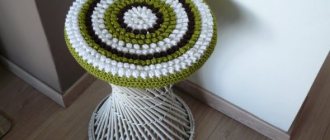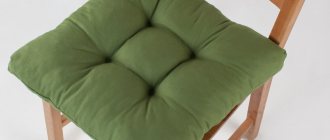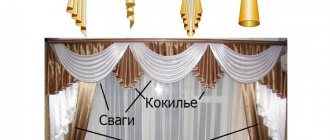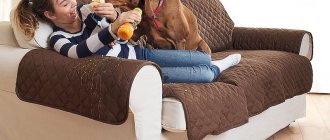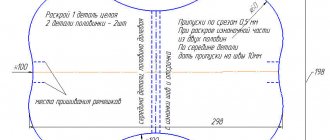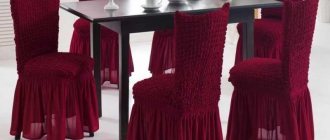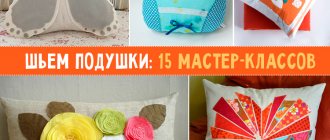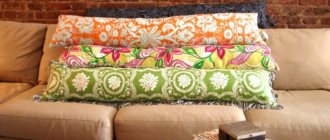Making chair seats with your own hands is a task that any person can do; there is nothing complicated about it. Without textile accessories, the interior of any room will be uncomfortable and cold. And the easiest way to add comfort and beauty to your home is to create soft seat covers for stools or chairs.
DIY chair seats
You can choose the material and type of the future product from thousands of options - it depends on the wishes and tastes of the home owners, as well as the general interior of the room, and financial capabilities. But, in any case, making textile decor yourself will help save your budget, as well as bring new colors to the design of your living space.
ABC of style
What does the interior style depend on? Each direction has its own characteristics, thanks to which the design idea and the main design idea can be easily guessed. To give the atmosphere freshness and lightness, it is important to be able to correctly complement the design with small details and place accents with the help of interior accessories.
These pillows look great inside
Textiles are especially important in home decoration. Undoubtedly, buying any product today will not be difficult, but if you strive to achieve exclusivity in design, bright and comfortable DIY chair cushions are a quick and easy way to get what you want.
Some general recommendations:
- Choose the right fabric. Remember that a soft cover for a stool with your own hands is not only beautiful, but also functional. Preference should be given to a material that combines excellent wear resistance, resistance to friction and paint fading.
- We select a color scheme. It would seem nonsense, but a pillow can become a full-fledged participant in a decorative composition if you choose the right shade and prints. For example, if you want to add unusual colors to your design, a pillow of a certain color will subtly evoke the desired associations.
- Combine chair covers with other fabrics in the room. This could be curtains, tablecloths, sofa upholstery, napkins. You can highlight an elegant accessory by using different decorative techniques or by choosing fabric with an unusual pattern.
- Several chair cushions made using the patchwork technique, made by yourself, will complement the design of the dining room, kitchen or living room in an original and unusual way. Vintage-style accessories with light scratches, buttons, antique lace and other distinctive details will give the interior a light, casual effect. If you master the art of knitting, you can decorate the product with a beautiful three-dimensional pattern. These cushions are especially suitable for garden furniture.
When choosing fabric, style, finishing method, it is important to remember functionality. Stones, beads, beads and other voluminous decor will decorate pillows, but such products are not practical in everyday life.
You can sew useful and original textile furniture with your own hands, this will save the family budget and decorate the room with style and elegance.
Textile accessories in the interior
The style of the interior is determined not only by its significant touches - such as the color and texture of the walls or the choice of furniture, but also by accessories. A special role is played by textile accessories that can add the necessary color accents, “dilute” the design of the room or, on the contrary, tie together several shades used.
The modern market allows you to easily purchase any textile, but you can achieve a truly exclusive and original design only if you give preference to hand-made items, that is, made by hand.
Interesting! You can look at the design of the chair seat in a store or on the Internet, and then implement the idea with your own hands.
Unlike pieces of furniture, textile items can be changed at least every month.
Some stylistic trends imply the presence in the room of stools or chairs with hard seats (for example, wooden or with a metal frame). To add comfort to such furniture, it is enough to place soft seats on a hard surface. In addition, such accessories allow you to change the design of the room as you wish. So, you can sew sets of such seats for different seasons (in winter - with Christmas motifs, in summer - green, and so on) or simply have two or three options in different colors.
Interesting! If you are good at sewing, you can make reversible seats. When you get tired of one color or ornament, you can simply turn out the cover and transform the room in a matter of minutes.
Overhead seats are much easier to care for than upholstered chairs, because they can be removed at any time and put in the washing machine. This option is well suited for decorating chairs in the kitchen, children's room, and hallway.
Seats on chairs can either duplicate the main textiles or stand out
Recommendations for fabrics for making textile seats
First of all, you need to correctly select the fabric from which the seat will be made. A soft pad plays not only a decorative role, but also a functional one, so the material for it must be resistant to friction, wear-resistant, and can withstand frequent washing.
Table No. 1. Fabric options for making seats.
| View, illustration | Description |
| Faux suede | Practical material that is very pleasant to tactile contact. Artificial suede has a very reasonable price, attractive appearance (there are hundreds of shades of this fabric), it is durable, easy to clean, and when treated with a special Teflon impregnation, it also becomes moisture-resistant and does not get dirty for a long time. It is enough to wipe such a seat with a damp cloth to remove minor dirt. |
| Flock | Durable non-woven material with a pleasant surface. This fabric has good breathability, is wear-resistant, looks expensive, but at the same time is practical. Flock chair cushions will be appreciated by pet owners - if a pet jumps on such a seat, it will be very easy to remove its fur by walking over the surface with a wet hand. At the same time, the flock tolerates frequent use well; it is difficult to leave a snag on it or tear it. |
| Artificial fur | A good option for pillows that will be used during the winter season. Faux fur looks great, quickly returns to its previous shape as soon as a person gets up from a chair, and is easy to clean. To decorate the chairs, you can choose plain fur in a neutral or bright color, or choose original options that imitate natural furs - for example, leopard, giraffe or zebra. |
| Fleece | Lovers of cozy and warm fabrics will appreciate the fleece chair seat. Fleece is even called an artificial analogue of sheep wool - for its ability to retain heat for a long time. This is a hypoallergenic material that tolerates washing well, does not fade, and is abrasion resistant. In addition, this lightweight but durable material has a very delicate texture that is incredibly pleasant even to bare skin. |
| Microfiber | The fabric from which towels are often made is also perfect for creating a chair seat. Microfiber perfectly absorbs water, it is strong and durable, and does not lose its brightness over time. You don’t need to think that the pillow will have a “towel structure” - in stores you can find ultra-thin microfiber, the fibers of which will be almost invisible. A microfiber seat is well suited for the kitchen or nursery - in short, rooms where there is a high probability that something will spill or spill onto the chair. |
| Cotton fabrics | Cotton-based fabrics such as satin, calico or poplin are an ideal solution for summer time, as well as interiors where a romantic, light, even slightly rustic style prevails. Cotton types of fabrics are pleasant to the body, hygroscopic and do not cause allergies, are very easy to care for and are machine washable. The only disadvantage we can highlight is that the cotton material wrinkles easily - this must be taken into account, since the seat will constantly be wrinkled. But if you pull the fabric tightly, there will be no problem. |
| Linen | Linen fabrics are an exclusively natural material, and therefore will appeal to lovers of environmentally friendly, natural and hypoallergenic textile accessories. Seats made of linen will breathe wonderfully, absorb moisture, this material is pleasant to the body. Linen is suitable for sewing a pillow on a high chair for feeding a small child - it is a completely safe fabric, aesthetically pleasing and lightweight. |
| Denim | Dense and hard cotton material is perfect for making seats for chairs in a teenager’s room, or for the interior of rooms in the loft, hi-tech or minimalist style. Jeans can maintain an aesthetic appearance for years, withstands washing, does not fade or fade. There are many shades of denim - you can choose a snow-white version, classic blue, or any other so that the pillows fit well into the overall design of the space. |
| Carpet | An unusual material for making chair seats, but very practical and durable. It is worth choosing soft carpet options on a hard base - then the pillow will be tactilely pleasant, at the same time durable and reliable. This seat does not deform and will not lose its visual appeal even during constant use. |
Having decided on the fabric, you need to pay attention to the choice of colors. It just seems that the cushion on the chair seat is a small thing. In fact, this accessory can become a necessary color accent or a full-fledged participant in the interior and decor of the room. It is better to combine chair seats with other shades already present in the design. Thus, textile decor can overlap with curtains or carpet, tablecloth or fabric napkins. You can choose pillows to match the color of the sofa or bedspread.
Sewing a bedspread with your own hands is another way to save money and an opportunity to bring a piece of your soul into the interior. Detailed step-by-step instructions for making a bedspread can be found in our special article.
If there are any color accents in the room, you can also support them with pillows. So, with a neutral color of walls, curtains and furniture, you can have bright flower pots, an unusual colored chandelier or noticeable photo frames - sew the seats on the chairs in this color.
Important point! If you order curtains or a bedspread from a studio, think in advance whether you will need decorative pillows. Even if you don’t want to use textile chair seats at the moment, you can save a few pieces of fabric left over from sewing so that you can use it at the right time and create a design in a single color scheme.
The color of the seats echoes the color of the walls and the pattern on the tablecloth
. Of course, chair cushions can not only be plain. The “patchwork” technique looks interesting, when the seat looks as if it was assembled from many scraps. The seats decorated with lace are interesting - they will fit perfectly into a room where a romantic interior predominates.
Fabric with polka dots or checks does not lose its relevance for many years, and if a bedspread or curtains with such a print seem too active to you, then chair seats will look great!
Reversible seat with different prints
It is worth considering that additionally you need to decorate the seats wisely. Yes, you can use lace fabric or embroidery, add appliqués to the finished product, or sew on fabric-covered furniture buttons. Other decorations, for example, bows or rhinestones, although they will look original, will seriously damage the functionality of the product.
Video – Decorative seats for chairs
Which seat filler should I choose?
Of course, fabric alone will not be enough to make a comfortable seat. Only the cover is sewn from textile material and placed on a soft base. There are several options for fillers, let's look at them in table form.
Table No. 2. Fillers for seats on chairs.
| View, illustration | Description |
| Sintepon | Light, elastic, but at the same time voluminous filler that is resistant to various deformations. Sintepon tolerates washing well and is considered a good option for stuffing a chair seat with it. |
| Foam rubber | The most common and inexpensive filler option. Foam rubber is available in various densities and thicknesses, so you can choose the ideal seat for each family member. The main advantage of foam rubber is that it is easy to cut, and the resulting part holds its shape on its own, serving as the basis for the cover. |
| Holofiber | Fibrous synthetic material in the form of small balls, can be produced either in the form of a sheet or in bulk. This is a hypoallergenic material, it is highly breathable, soft and elastic, but at the same time holds its shape well and does not deform. |
| Latex | Furniture latex is an elastic, comfortable and durable material - a seat filled with such filler will last eight to ten years without any problems. The disadvantages of the material are high cost and relatively significant weight. |
| Batting | Batting is an inexpensive, but natural and safe material that absorbs moisture well and allows air to pass through. Batting is even suitable for making children's mattresses, which indicates its high level of environmental friendliness. But, products made from batting have a significant weight, such a filler will take a long time to dry, and with frequent washing it can separate into layers. |
| Polyester | A synthetic fiber used to stuff pillows, blankets and even thin mattresses. A highly breathable, lightweight material, however, polyester has a lifespan of about three years, after which the filler may clump. |
| Polyurethane foam | The material is classified by hardness, so you can make both a very soft and quite elastic, hard seat for the chair. Thanks to perforation, polyurethane foam weighs a little, has good air permeability, and has a memory effect. |
Stages of work
When working, you must follow a strict sequence of actions. If the stool is square, measure the length and width of the seat; if it is round, measure the diameter. The pattern must take into account the necessary seam allowances - up to 2 centimeters on all sides, at least 1.5 cm. The height reserve and seam allowance in the filler are approximately the same. The step-by-step instructions are as follows:
- Creating a template (it is possible to use a ready-made one, adapting it to specific seat sizes).
- Cut a circle or square from the filler to the desired length and width.
- Sewing elements and edge processing.
- We sew in an elastic band.
- Attach the cushion to the seat cushion of the chair.
Characteristics of the “growing” Kidfix chair, advice on selection and assembly
The nuances of the seam depend on the type of fastening. If you make a cover for a stool with your own hands in the shape of a square, the cords are sewn to the end, gathers are formed along the bottom of the circle, and an elastic band is inserted. Step-by-step instructions for the first option:
- Place the lining with the right side facing the main fabric.
- Insert the laces and hand stitch them to the seat.
- Sew on the machine, leaving the bottom part untouched.
- Turn the finished product upside down.
If the seat is round, the sequence of actions will be slightly different. The elastic is attached to the fabric from the inside. When sewing, it is carefully held, and the product itself is slowly rotated in a circle. The cover is stuffed with foam rubber (polyester filling), placed on a stool and straightened out so that there are no folds or distortions anywhere.
The final stage of sewing chair cushions is decorating the product. The most common option is to trim the edge with decorative braid. Even small tassels or fringe made from thick woolen threads will look original. For decoration, you can use an applique of a patch of any color.
Build a model based on the dimensions of the chair seat
Cutting out a template from cardboard Finished products
Place the filler between two pieces of fabric Mark with a ruler and pencil, this will make it easier to sew the seam Secure with clips
Quilting a product according to marks
Trim raised edges to pattern Mark bond locations Sew around perimeter for easy basting
Baste the binding, leaving ties on both sides Fixed corners Finished area
Secure the product to a chair
How to decorate
Each housewife has her own ideas for decorating. Some people decorate with buttons, others with fringes. You can also sew on various laces, beads or rhinestones and make patterns out of them. The most original ways were to decorate with plant prints, lace or embroidery and appliqués.
Knitted roller under the neck or for hugging
Decorating a pillowcase with plant prints
Decorating with floral patterns involves transferring prints of fresh leaves or grass onto a pillowcase, creating combinations and patterns. To implement this idea you will need:
- Freshly picked plants;
- Natural light fabric;
- Scissors and hammer;
- Parchment.
Tools
The process itself involves laying the plant on a cloth and covering it with baking parchment. Next, it is hit firmly and evenly with a hammer, which allows the plants to secrete juice, which is absorbed into the fabric and leaves a pattern on it. Such pillows require careful care. Pillowcases should be washed in warm water with a delicate cycle and detergent.
Stuffing process
Lace, knitting and embroidery
This method is quite labor-intensive, but it will give the products a unique appearance and aesthetics. Knitted pillows have a certain advantage over sewn ones. Firstly, they are embossed, and secondly, all the seams are very easily masked in them. Knitting such a product yourself, of course, takes a long time, but making it from an old sweater is as easy as shelling pears.
Embroidery on pillows also requires skills and knowledge of what exactly you want to depict with threads. It could be any patterns, flowers, or just chaotic straight or broken lines. It's even easier with lace. You just need to buy them or detach them from old products and attach them to pads. Lace can be made from old tulle.
Newborn pillow
How to properly sew an applique onto a decorative pillow
Also quite an interesting type of jewelry. Pillows with appliques can be used not only for decoration, but also for sleeping due to the fact that this decoration sits very tightly on the cover or pillowcase. The step-by-step algorithm of actions here is something like this:
- Prepare a pattern and cut out the base of the pillow with seam allowances;
- Cut out appliqués of the required size from decorative material;
- Pin and baste the applique using a decorative stitch or overlock stitch on a sewing machine;
- If desired, attach decorative braid;
- Sew both pieces of the pillowcase to complete the pillow.
Decorative pillows from old pants
In conclusion, I would like to say that sewing a pillow with your own hands is not so difficult. After completing any master class on sewing pillows, even a novice craftswoman will be able to learn how to make both simple pillows for sleeping and sofa decorative items, pillows and crib bumpers for babies and newborns.
How to make a knitted round chair cushion
Each of us is free to decide whether to sew a cushion on a stool or, for reasons of preference, make a knitted version. In the second case, a soft item for interior decoration and increased comfort is crocheted or knitted. To make a round chair cushion with your own hands, focus on a circular pattern.
Such items are often made in the form of thin bedding for benches, plastic or wooden chairs, or on the back of a chair.
Note! If you prefer knitting, it won't be difficult to create colorful seats using the patchwork technique. To do this, the product is made by connecting multi-colored rhombuses, squares, etc.
Making soft knitted items from pompoms is not difficult. For their manufacture, remnants of any colored thread, pre-wound on a template or fingers, are suitable. To get a fluffy ball, the base needs to be tied in one place, cut out and ruffled. Well then, the pompoms are tied at the same distance to a plastic mesh base, curtain fabric or crocheted weave. Alternatively, knitted pillows can be brushed at the corners.
Additional Information! Stool seats look especially good if they are knitted with molded threads that look like “fur” or “grass”. Also, the density and pattern of knitting is at your discretion.
Choosing a pillow shape
The shape of the product also has practical significance. For example, some models can be conveniently combined with chairs in the dining room or modeled to fit the size of a car seat. The following standard forms for accessories are distinguished:
- Rounded model. A cushion for a round chair is the best option for DIY sewing.
- Square model. Very often it is equipped with side latches, which allows you to take the accessory with you on a trip.
- Cylindrical pillow models. Most often used as retaining orthopedic products (for the cervical or lumbar spine).
There are also wedge-shaped and cushion-shaped pillows, but they are more specialized and are used for patients with injuries and disorders of the musculoskeletal system.
Selection of materials for sewing
Today, the choice of fabrics is quite large - natural, synthetic and mixed fibers are available to the modern buyer.
Each of them in practice has a number of advantages and disadvantages:
Natural fibers. These include linen, cotton, and silk fabrics. They have a rich natural pattern. The fabric is very porous, which maintains air circulation, prevents unpleasant odors from accumulating and prevents the skin from sweating.
Seat pillow: recommendations before surgery
In order for the new “brainchild” to be comfortable, durable and delight the owners, it is necessary to take into account several features.
- Choosing the right material. He must be not only beautiful. The main advantage is functionality, so when purchasing fabric, craftswomen pay attention to fading resistance, strength, and density.
- Color, texture. To avoid disharmony, you need to take into account the style of the room in which new textile “inhabitants” will appear. The fabric of the seat should not stand out from the overall picture. Clumsiness is not welcomed, but the use of a contrasting solution is allowed when it is intended to enliven the interior.
Required Tools
To make your own chair cushion, you will need the following materials:
- fabric chosen for upholstery;
- filler;
- cord for edging;
- lightning;
- string tapes (or other fastening methods);
- decorative elements.
In addition to materials for sewing soft seats for chairs and stools, you will need the following tools:
- roulette;
- sewing machine;
- needles;
- wires;
- scissors.
When everything is ready, you can start making the pillow.
Crazy patchwork technique
Chair seat made using crazy patchwork technique
Necessary materials:
- scraps of fabric in bright colors;
- filler;
- threads, braid to make ties.
Progress:
- make a pattern;
- cut out the shreds - if it is a circle, the shreds look like slices of pizza, if it is a square, then the shreds are rectangular or square;
- cut out a whole part - you get the second side of the pillow;
- sew patches;
- sew two parts of the pillow, fill with foam rubber or holofiber;
- carefully sew up the remaining edge;
- sew strings.
Chair cushion patterns
Preparing your pattern is the first step to sewing. For a square cushion, measure the size of the seat. There is a 1.5 cm indentation on each side. Cut out the stencil, attach it to a piece of fabric, and mark it with special chalk.
Cut 2 identical squares
For a round pillow, models are prepared in different ways. It is difficult to measure such a shape with simple tape, so place a piece of cardboard on the surface of the chair and mark it. The circle is increased by another 1.5 cm.
Next, apply a stencil to the fabric and cut out 2 parts
Knitted pillow
Crochet pattern for a soft chair cushion
Both knitting and crochet are suitable for knitting. If there are any threads left, they should be used here. Knitwear, preferably tightly knitted. Model it however you want. The corners are decorated with tassels.
Chair cushion “Chess”
Knitted cushions for a chair or stool in brown melange color
Knitting covers for stools
In almost every home there are stools in the kitchen, faceless and unattractive. You can add a bright personality to the stools and fit them into the color scheme of the kitchen by tying covers on them. Knitted stools create comfort, coziness and a cheerful mood in the room.
To knit covers, you can use a three-dimensional crochet pattern made from “popcorn” elements, which is a cone of columns. The knitted pattern of cones will make the stool seat lush and original in appearance.
For knitting covers, it is better to use thick acrylic yarn and a thick hook. Choose yarn colors to suit your taste.
In the example, the covers are connected to square stools. To knit a square, make additions at its corners by knitting two elements from one arch. You can knit a cover for a round stool using the rules of addition for knitting a circle.
Description of knitting a cover for a stool:
To start knitting a square, cast on a chain of 8 chain stitches. and close it into the ring of the connection art. To knit the first row, make 3 chain stitches. lifting, tie 4 tbsp. s/n from the ring.
Now form the first bump, to do this, remove the hook from the working loop and insert it first into the 3rd lifting loop, then again into the working loop. Pull the working stitch through the first one and the group of stitches will come together into a knob called “popcorn”.
Next *knit 4 chain stitches, 5 stitches from the ring. s/n. Insert the hook into the top of the first stitch, then into the working loop, pull the working loop through the top of the first stitch.* Repeat from * to* 2 more times, complete the row - chain 4, joint st. to the top of the first bump.
To knit the second row, make 3 chain stitches. rise. In the second row, knit 2 cones from each arch, 4 chain stitches between them, and make 3 chain stitches on the sides of the square. The first bump consists of lifting loops and 4 tbsp. s/n, and all the following cones from 5 tbsp. s/n.
In the third row of corner arches, knit 2 cones, 4 chain stitches between them. On the sides of the square there are 3 air points, a cone from an arch, 3 air points. Finish the row of joints. to the top of the first bump.
Knit all subsequent rows using the same principle. From the corner arches, knit 2 cones, 4 chain stitches between them, and on the sides of the square from each arch, knit one cone through 3 chain stitches.
Come up with the color of the square yourself. A case with a bright center and transitioning to darker colors towards the edges looks good.
To transition colors, after finishing a row, fasten and cut the thread, and to knit the next row, attach a thread of a new color.
Having knitted a square along the seat of the stool, knit 2 rows of cones without adding in the corners, and in the last row knit cones through 2 chain stitches. Having thus narrowed the cover at the base, pull it over the stool, fixing the corners along the seat.
Knitting pattern for a square of cones:
Sewing a cover for a stool with a fold
The stool seats often fly off and do not hold well without additional fasteners. You can create additional fasteners, but rarely such small details can be successfully made with your own hands. It's better to try a folded pillow.
A fold is a small “extra” piece of fabric that can be placed next to the seat of a chair. The edges of this area are adjacent to the bottom of the wooden seat; Equipped with an elastic band for a perfect fit to the chair.
For such a seat, you will need foam rubber with a cover (you can make it quilted or simply cover the foam rubber with fabric) and a strip of fabric to match the cover, which will be used for fastening. You can take a ready-made case and add a holder, or you can sew it from scratch.
A strip of raw cotton or cotton is attached to the perimeter of the stool cover. It should be wide enough to allow about a third to be glued to the sides of the lid, with the rest lying below. The strip is roughly sewn to the cover, first folded in half and sewn in half. You need to leave room to put the elastic on.
When the strip is already sewn to the sides of the seat, you need to thread the elastic and finally sew it. Machine processing can be used for strength.
Useful tips
Do-it-yourself chair cover: how to sew soft covers for chairs and armchairs (130 photos and videos)
Sewing a chair cover is quite simple, but nevertheless there are several important rules that will help you significantly save time and avoid many mistakes when working with fabrics:
- Calculate the dimensions. Once you have made all the necessary patterns, you will need to calculate the required fabric consumption. Check your measurements carefully and don’t forget about seam allowances and all other details of the cut. It is advisable to sew with a margin, because if the product shrinks after washing, you may simply not be able to put it on the chair.
- Train on cheap material. If you haven't tried sewing before, try your hand at toy furniture. As a practice, you can sew a full-size cover, but use cheap old fabric, such as an old sheet.
This way you can not only practice cutting and sewing, but also experiment with style and decor.
- Don't forget about the fasteners. The product should be tightly fixed to the chair, so use reliable ribbons so that you can tie them around the legs of the chairs. For universal models, choose longer ribbons, since the height of the legs may differ for different furniture and this must be taken into account.
- Don't use too expensive material. If you are sewing a product for work areas like the kitchen, you should not buy too expensive fabric. Expensive jacquard is also not suitable for a dining room, because food can leave permanent stains, and expensive materials are unlikely to withstand treatment with stain removers. To avoid spending extra money on dry cleaning, use cotton or an inexpensive blended fabric.
By following all the advice of professionals and practical recommendations, you will be able to make practical and beautiful covers without much effort. And by using your imagination, you can turn them into real works of art, decorating them with unusual decor or embroidery.
With the help of the right materials and colors, you can refresh the interior; you just need to know how to properly sew chair covers with your own hands. Such products will hide all external scratches and defects, but you will still be able to enjoy the comfort and durability of your favorite chair.
Decoration
Whatever option is chosen for making pillows, they can later be decorated with additional decorative elements. But here it’s worth thinking about what this piece of furniture is needed for. If the pillow is needed only as a room decoration, it can be decorated with beads, beads, sequins and much more. If it is to be used for its intended purpose, it is better to discard such items.
You might find it interesting. Fantastic models of women's vests - sew them yourself
Applications
To ensure that nothing causes discomfort when sitting in a chair, it is necessary to decorate the pillows with materials that are not too bulky. These can be various applications, fringe or buttons. The latter not only decorates the product, but also prevents the filler from moving in clumps.
Buttons
It is best to trim buttons with fabric. The color is chosen as a pillow or under it. After this, the surface of the product is marked so that the decorations are located at an equal distance from each other. In the indicated places, the buttons are tightly sewn to the pillow.
DIY pillows
Therefore, it is clear that sitting on stools with your own hands is quite simple. It is enough to stock up on the necessary materials and patience. And ready-made decorative elements will decorate and subsequently update the appearance of the apartment.
Decorative elements
Beautiful buttons for pillow decoration
Buttons are a universal item. They are sewn on so that the filler does not bunch up into lumps, and at the same time they will decorate the product.
It is better to avoid using rhinestones, beads, and decorative stones when decorating. This is not very practical to use.
Original model using the “Biscuit” technique
Seats made using the biscuit technique are very popular. They look impressive and last a long time. Making such a pillow for a table is not difficult. Step-by-step algorithm of actions:
- Measure the seat taking into account seam allowances (5 cm on all sides).
- Cut out the main part of the product, guided by the numbers obtained.
- Cut the fabric into many squares of the same size.
- Place the pieces in front of you on your work surface.
- Sew so that they form several rows stretched horizontally.
- Sew the top lines, forming even folds along the sides of the square.
- Sew vertically.
- Fill the finished pockets with holofiber or synthetic down.
- Apply a new portion of parts face down onto the bottom of the seat with your own hands for the chairs of the resulting row, draw a line.
- Add foam or synthetic pile filling.
How to choose an orthopedic chair cushion based on shape and material
In addition, the process of making a chair cushion with your own hands is repeated several times, depending on the size of the seat. The final stage of work is to sew a braid or lace along the edge. The second option will look especially good in a Provence style kitchen.
Each craftswoman can make furniture at her own discretion. As a result, you should have an original DIY chair cushion that resembles a patchwork quilt. It is better to choose a light fabric decorated with floral motifs.
The preferred shape of this type of kitchen seat is square, since the product consists of a large number of parts of the same size. The threads should be the same tone as the fabric so that they are not noticeable. The recommended type of fastener is thin laces at the corners. This model will look especially good on classically shaped wooden chairs with a curved back, but will also fit perfectly with regular stools.
Do-it-yourself soft seats for chairs and stools are sold in any home textile store. However, a handmade product has its own unique charm, and this fact cannot be underestimated. During manufacturing, care should be taken to ensure that the color of the selected material is in harmony with the color of the furniture and the decoration of the room.
Prepare a sturdy base for the chair seat Cut the base fabric into squares of the same size
Sew rows of 5 squares Baste the details to the main fabric
Sew along the markings, forming “pockets” from squares
These are cells. Fill the prepared “pockets” with holofiber or synthetic fluff. Secure a new row of squares.
Sew from inside Turn over
Fill the pockets again with putty. We continue to work by analogy with the previous lines. 4 finished rows.
The seat is completely finished
Sew satin ribbon around the perimeter for decoration
Textile
When choosing a material, it is advisable to pay attention to wear-resistant, durable fabrics: rep, teak, satin. If the chair is in a cold room, then wear-resistant felt would be an excellent choice. The length of the fabric depends on the size of the chair.
Stylish stripes will add brightness to the interior
It is better to choose the color of the material so that it is in harmony with other interior items - for example, with the colors of curtains, a painting decorating the wall.
Original soft cushions for kitchen chairs
Pillow care
All items that come into contact with people in one way or another require sanitary and hygienic procedures. Benches will be no exception. It is noteworthy that proper care of them extends their service life and maintains their attractive appearance and shape. The appropriate procedures depend entirely on the design features and type of filler.
Bright decorative pillows have a great effect not only on the mood, but on the entire room as a whole.
In some cases, washing is allowed (by hand or delicate machine wash). If light and plain products can be placed in water with a temperature of 40 degrees, then the presence of bright and combined shades forces the use of extremely cold water. Some products can only be dry cleaned by a professional dry cleaner.
Dry the product in a horizontal position. This is the only way to prevent the filler from churning. When opening the seat, do not allow folds. The item must be turned upside down from time to time. Ironing is not recommended.
To change the mood and dynamics of the interior of the room, just change the blankets to decorative pillows and you will get new unforgettable experiences from the comfort and relaxation zone.
If you follow all the instructions regarding sewing, operation and care, things will delight us with comfort and aesthetics for a long time. In addition, making cushions for stools and chairs does not require any special skills. It is also important that DIY projects boost self-esteem and serve as a great opportunity to decorate your home without spending extra money.
Types of pillow filling
The filler, its quality and basic properties, play an important role in functional terms. Today, any buyer has the opportunity to purchase a variety of types of filler:
Polyurethane. The material is classified according to its degree of rigidity, which allows you to sew pillows with a “shape retention effect.” Polyurethane has a long service life (more than 6 years) and sufficient strength. Great for sewing neck pillows and accessories for the lumbar spine.
Latex is an excellent material for sewing high-quality orthopedic accessories. It is characterized by increased strength, a sufficient degree of porosity and wear resistance.
Polyester. Cheap and high-quality base used to make retaining pillows. Products made from polyester are very light and soft and hold their shape well. A significant disadvantage of use is its short service life.
Note!
- Children's blanket: criteria for choosing a blanket for children. A variety of sizes, materials and patterns of children's blankets. Rules for caring for a child’s blanket (photo + video)
Bedspread for a sofa: TOP-140 photos and videos of design options for a bedspread for a sofa. Features of the use of the bedspread, choice of color and material
- Wool blanket: options for using wool blankets. Advantages and disadvantages of wool, varieties of sizes and shapes of blankets (photo + video)
When choosing a filler, you should carefully evaluate its basic qualities and properties in order to achieve the desired result in practice.
Requirements for a homemade pillow
Regardless of the shape, size and type of accessory, a handmade pillow must meet certain requirements:
- For sewing, use only high-quality materials.
- Features a removable cover that is wash and shrink resistant.
- No toxic paints when decorating the pillow.
- The fabric used for sewing must have sufficient porosity.
- No sliding surface.
A big plus will be the presence of orthopedic properties that allow increasing blood flow to the pelvic organs and unloading the venous bed of the lower extremities.
New life for an old carpet
The easiest way to decorate furniture is with carpet. In addition, this is a great way to use old and unnecessary carpet that you would hate to throw away.
Carpet is a fairly soft and pleasant-to-touch material, but at the same time it is resistant to deformation and very dense. To make a carpet cover, you need to cut the material into a square or round shape, the choice depends on the chair for which the cover is being prepared. Just leave ten centimeters at each edge, this is necessary to secure the cover.
To maintain the shape, sew the edges with thread. You can use thick or woolen threads. If you have a braid that goes well with the design of the carpet, then you can use it instead of threads.
Preparing the ties
First of all, you need ties to prevent the pillow from slipping off the seat. But sometimes they can be used as product design elements. Beautiful ribbons, laces, cords and just strips of fabric are suitable for tying ties.
Strings
After completing the preparatory work, select the master class you like on sewing a pillow, and then follow all the steps according to the instructions. It is worth considering the simplest manufacturing option, which even a novice needlewoman can handle.
Knitting patterns for volumetric seats
Very beautiful three-dimensional patterns are obtained using the diagrams below.
Well, color – color always plays a decisive role.
Mounting options
To prevent the seat cushion you made from sliding on the chair, it must be fixed. There are several mounting options.
- For square chairs, it is enough to sew 4 small elastic bands in the corners of the cushion.
- The round one is fastened with an elastic band around the perimeter, for which a drawstring is sewn to the product.
- You can attach the seat cushion to a chair with a backrest by connecting 2 laces at the corners and tying them in a knot under the seat. They are usually made from the same material as upholstery fabric.
- The easiest way to attach it is with regular Velcro, which is attached to the edges of the pillow.
All fastening options are selected taking into account the type of finished product.
Drawstring With elastic band around the perimeter Velcro
We make chair seats with our own hands
Looking at the textile seats for chairs presented in stores, you can already imagine how to make the same ones yourself. The principle of sewing such pillow seats is approximately the same, only the shape, thickness and design of the finished products differ. Below we will talk about the technique of making several options that will not take much time and are suitable even for beginners.
You can make seats with your own hands that will be no worse than store-bought ones.
Simple chair seat: step-by-step instructions
To make a simple seat, we will need fabric, bias tape in the same color and a sheet of padding polyester. You will also need the following accessories:
- tailor's scissors for fabric;
- sewing machine;
- thick cardboard;
- tracing paper and felt-tip pen;
- threads and needles. Advice from professionals on choosing a sewing machine
Having prepared everything you need, you can get to work.
Step 1. We make a pattern for the future seat. To make a product exactly in the shape of a chair, you need to put tracing paper on the seat, trace it with a felt-tip pen, and then transfer this part onto thick cardboard. The pattern is ready.
A pattern made of thick cardboard exactly according to the shape of the chair seat
Step 2. We make a cover for the seat. To do this, you need to fold the prepared fabric in half, attach the pattern on top and trace it, leaving about two centimeters for allowances. Then the parts are cut out with scissors.
Seat details
Step 3. The resulting fabric parts need to be stitched on a sewing machine so as to obtain a diamond-shaped pattern. Next, you need to sew three sides of the finished parts, place the padding polyester inside and carefully sew up the fourth side.
Stitching will make the seat more voluminous and decorative
Step 4. Bias tape is attached around the perimeter of the seat. Leave a margin at two corners to create ties, which will then be fixed to the chair legs.
This is what the finished product will look like
Seat made from pompoms: step-by-step instructions
To make such an original seat you will need the following:
- synthetic perforated mesh (can be bought in craft stores);
- thick threads for knitting the desired colors;
- scissors.
Have all the necessary materials at hand
Step 1. Apply the mesh to the chair and cut the blank to the size of the seat. If you wish, you can make the seat round or square - then you need to make sure that it will not be larger or smaller than the seat of the chair.
Cutting out the base for the seat
Step 2. Let's start making pom-poms. To do this, you need to wind the yarn around your fingers, and when you have a rather fluffy skein in your hands, you need to tie it in the middle with thread, and then cut the edges on both sides, as shown in the illustration.
You can quickly make the required number of pompoms if you involve an assistant in the process
Step 3. We tie the pompoms to the mesh so that it is not visible. The main thing is to carefully secure the threads so that the decor does not come off from the finished product.
Pompoms are tied by the “tails” obtained during the manufacturing process
You can use pompoms of the same color, or choose two or three shades and combine them with each other.
Type of finished product
Volumetric seat: step-by-step instructions
The voluminous seats in the patchwork style look very unusual. Of course, it will take more time to make such an accessory, but the result will be impressive.
To complete the work we will need:
- 32 square pieces of fabric of different colors;
- matching threads;
- sewing machine;
- filler.
Step 1. Arrange the pieces of fabric in the desired sequence. At this stage, it is important to arrange the patterns and colors; then there will be no opportunity to change the fabrics.
In order not to forget the sequence, you can take a photo of the layout
Step 2. The pieces of fabric are turned over to the wrong side and placed next to each other so that the edges overlap in a checkerboard pattern, as shown in the illustration.
The overlap allowance should be about a centimeter
Step 3. We sew the parts together on a sewing machine so that we first get four long strips, each of which will have four squares of fabric.
At this stage, you can swap the stripes if you wish.
Step 4. Now you need to stitch the strips on a sewing machine to get a square seat piece. Then similar actions need to be done with the remaining pieces of fabric to get the second side of the seat.
To prevent the stripes from falling apart when sewing, you can pin them with French pins
Step 5. The finished sides of the seat should be carefully ironed to press down those parts that overlapped. If you skip this step, unsightly stripes may appear on the finished product.
Be careful not to let the iron burn the fabric.
Step 6. The blanks are sewn on three sides, then filler is added and the free edge is sewn up. The seat is ready!
Note that such a seat can be sewn from a larger number of scraps, then their sizes should be smaller
Experienced craftswomen sew not only square or rectangular pieces, but also make pillows from scraps of the most varied shapes.
Important point! The smaller the pieces of fabric, the more colorful the seat will be, so it is recommended to follow this method - the larger the pieces, the more contrasting and bright they can be; the smaller the pieces of fabric, the more similar in color they should be chosen.
